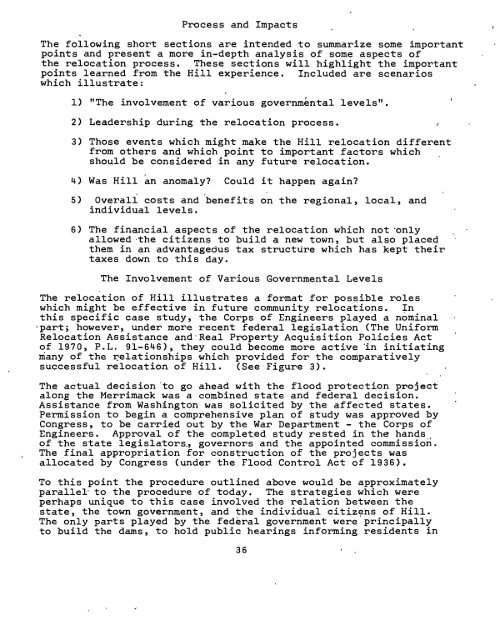; SP- IWR° CONTRACT REPORT 78-4... , UNDER ... - IWR - U.S. Army
; SP- IWR° CONTRACT REPORT 78-4... , UNDER ... - IWR - U.S. Army
; SP- IWR° CONTRACT REPORT 78-4... , UNDER ... - IWR - U.S. Army
You also want an ePaper? Increase the reach of your titles
YUMPU automatically turns print PDFs into web optimized ePapers that Google loves.
Process and Impacts<br />
The following short sections are intended to summarize some important<br />
points and present a more in-depth analysis of some aspects of<br />
the relocation process. These sections will highlight the important<br />
points learned from the Hill experience. Included are scenarios<br />
which illustrate:<br />
1) "The involvement of various governmental levels".<br />
2) Leadership during the relocation process.<br />
3) Those events which might make the Hill relocation different<br />
from others and which point to important factors which<br />
should be considered in any future relocation.<br />
4) Was Hill 'an anomaly? Could it happen again?<br />
5) Overall costs and benefits on the regional, local, and<br />
individual levels.<br />
6) The financial aspects of the relocation which not 'only<br />
allowed the citizens to build a new town, but also placed .<br />
them in an advantageous tax structure which has kept their<br />
taxes down to this day.<br />
The Involvement of Various Governmental Levels<br />
The relocation of Hill illustrates a format for possible roles<br />
which might be effective in future community relocations. In<br />
this specific case study, the Corps of Engineers played a nominal •<br />
'part; however, under more recent federal legislation (The Uniform<br />
Relocation Assistance and - Real Property Acquisition Policies Act<br />
of 1970, P.L. 91-646), they could become more active In initiating<br />
Many of the relationships which provided for the comparatively<br />
successful relocation of Hill. (See Figure 3).<br />
-<br />
The actual decision togo ahead with the flood protection project<br />
along the Merrimack was a combined state and federal decision.<br />
Assistance from Washington was solicited by the affected states.<br />
Permission to begin a comprehensive plan of study was approved by<br />
Congress, to be carried out by the War Department - the Corps of<br />
Engineers. Approval of the completed study rested in the hands . ,<br />
of the state legislators, governors and the appointed commission.<br />
The final appropriation for construction of the projects was<br />
allocated by Congress (under the Flood Control Act of 1936).<br />
To this point the procedure outlined above would be approximately<br />
parallel' to the procedure of today. The strategies which were<br />
perhaps unique to this case involved the relation between the<br />
state, the town government, and the individual citizens of Hill.<br />
The only parts played by the federal government were principally<br />
to build the dams, to hold public hearings informing residents in<br />
36







